Poinciana Regia on:
[Wikipedia]
[Google]
[Amazon]
''Delonix regia'' is a species of flowering plant in the bean family , subfamily
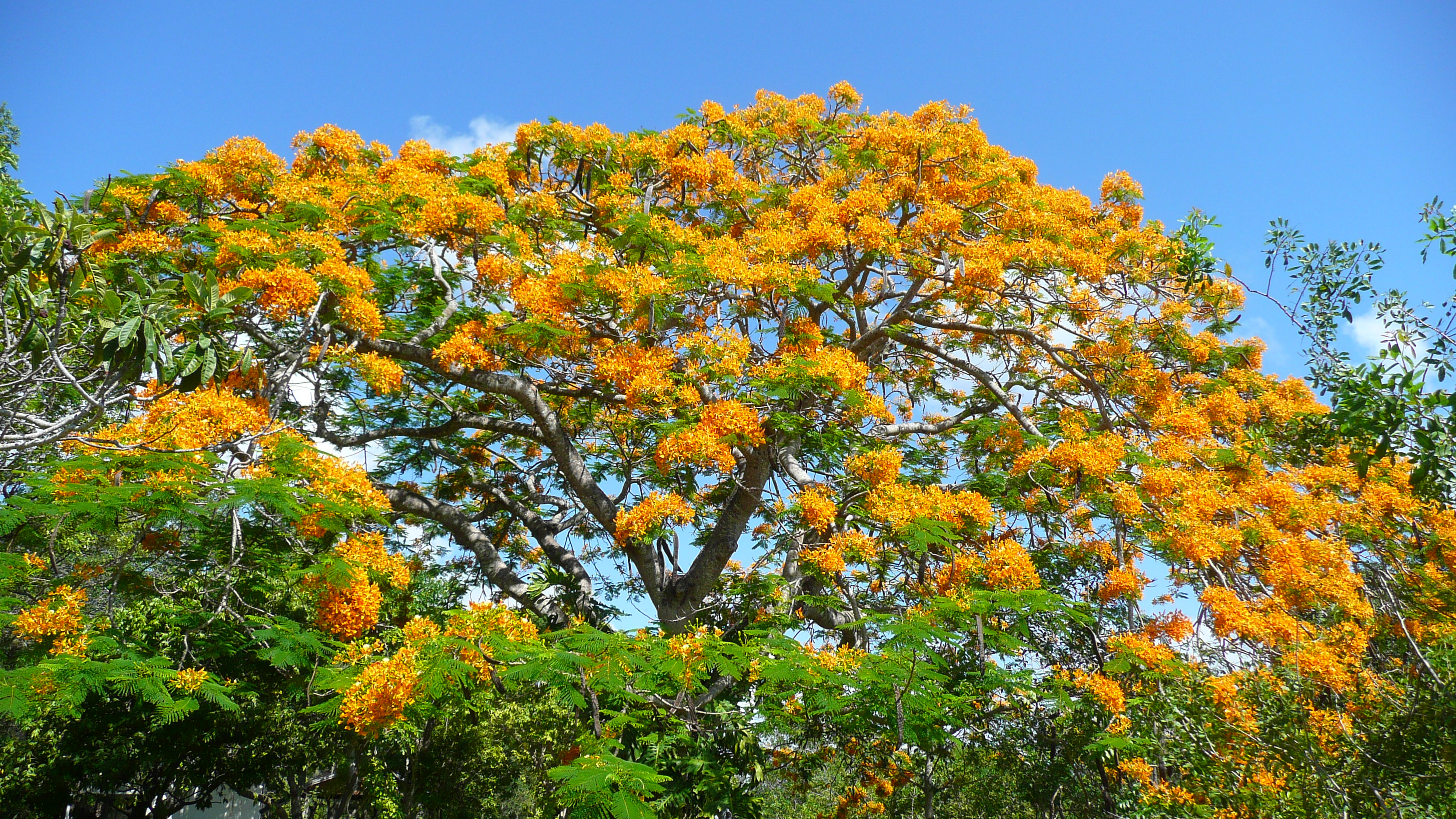
 The flowers of ''Delonix regia'' are large, with four spreading scarlet or orange-red petals up to long, and a fifth upright petal called the standard, which is slightly larger and spotted with yellow and white. They appear in corymbs along and at the ends of branches. The naturally occurring variety ''flavida'' (Bengali: ''Radhachura)'' has yellow flowers. The pods are green and flaccid when young and turn dark-brown and woody. They can be up to long and wide. The seeds are small, weighing around on average. The compound (doubly pinnate) leaves have a feathery appearance and are a characteristic light, bright green. Each leaf is long with 20 to 40 pairs of primary leaflets or pinnae, each divided into 10ŌĆō20 pairs of secondary leaflets or pinnules. Pollen grains are elongated, approximately 52
The flowers of ''Delonix regia'' are large, with four spreading scarlet or orange-red petals up to long, and a fifth upright petal called the standard, which is slightly larger and spotted with yellow and white. They appear in corymbs along and at the ends of branches. The naturally occurring variety ''flavida'' (Bengali: ''Radhachura)'' has yellow flowers. The pods are green and flaccid when young and turn dark-brown and woody. They can be up to long and wide. The seeds are small, weighing around on average. The compound (doubly pinnate) leaves have a feathery appearance and are a characteristic light, bright green. Each leaf is long with 20 to 40 pairs of primary leaflets or pinnae, each divided into 10ŌĆō20 pairs of secondary leaflets or pinnules. Pollen grains are elongated, approximately 52 
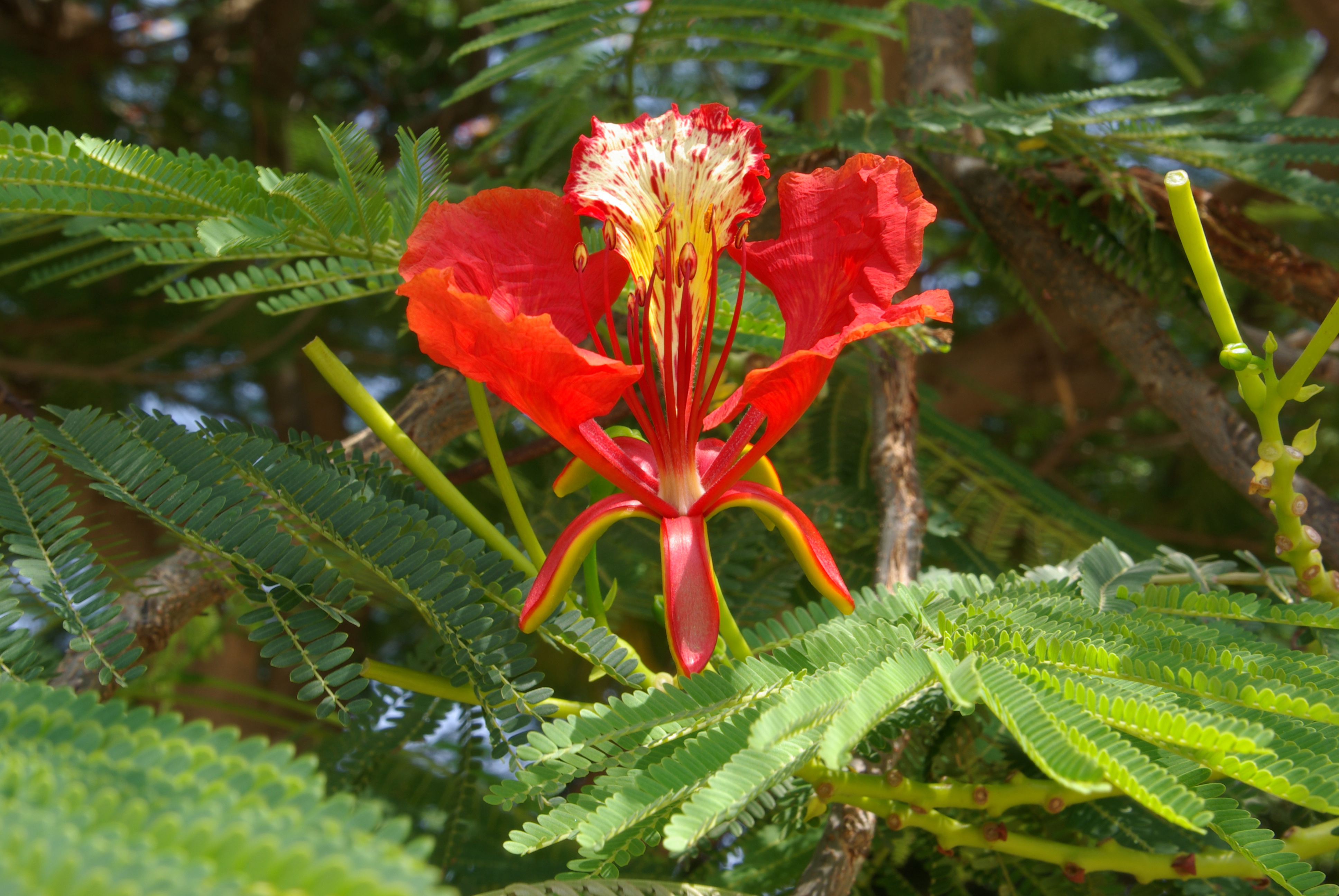
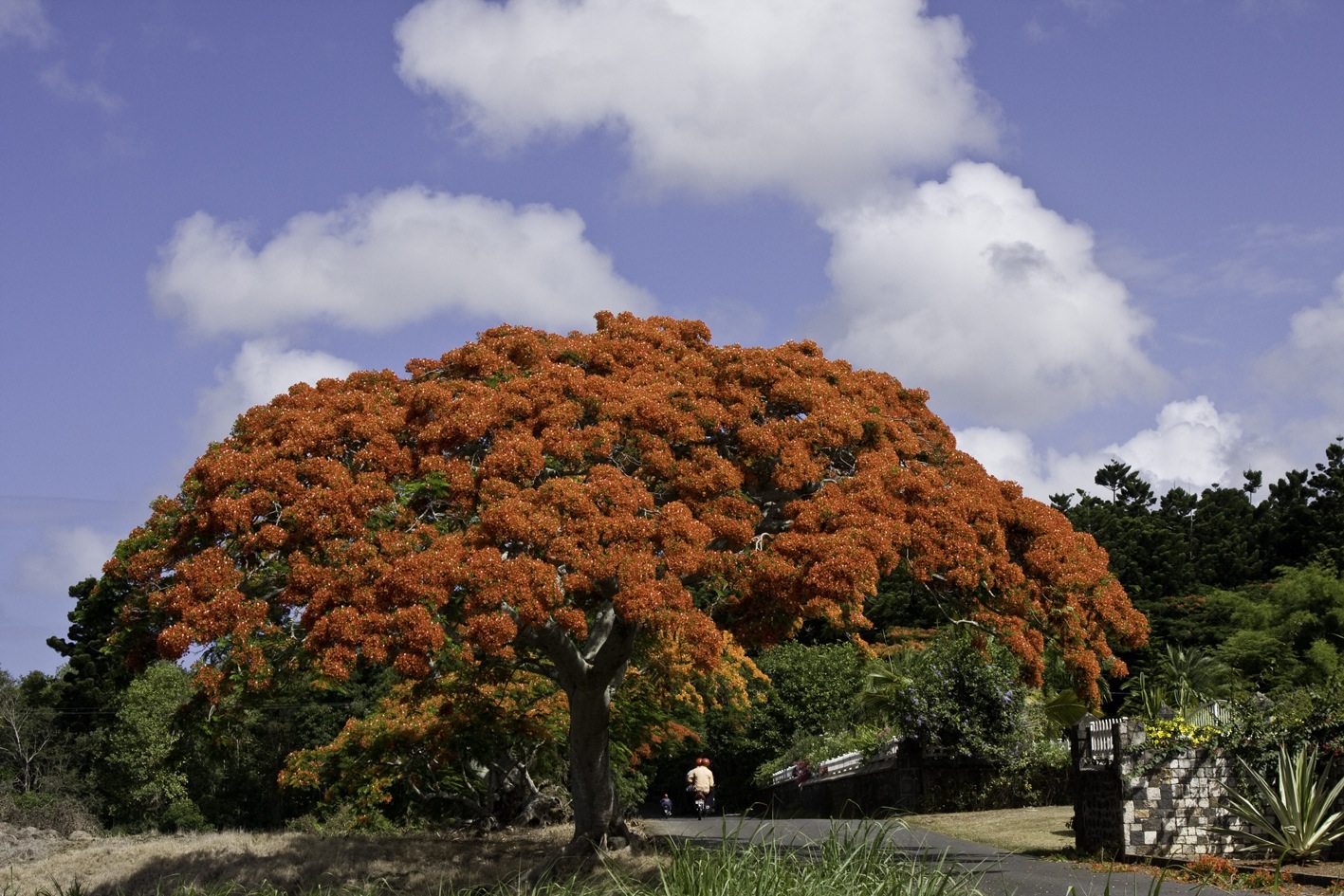

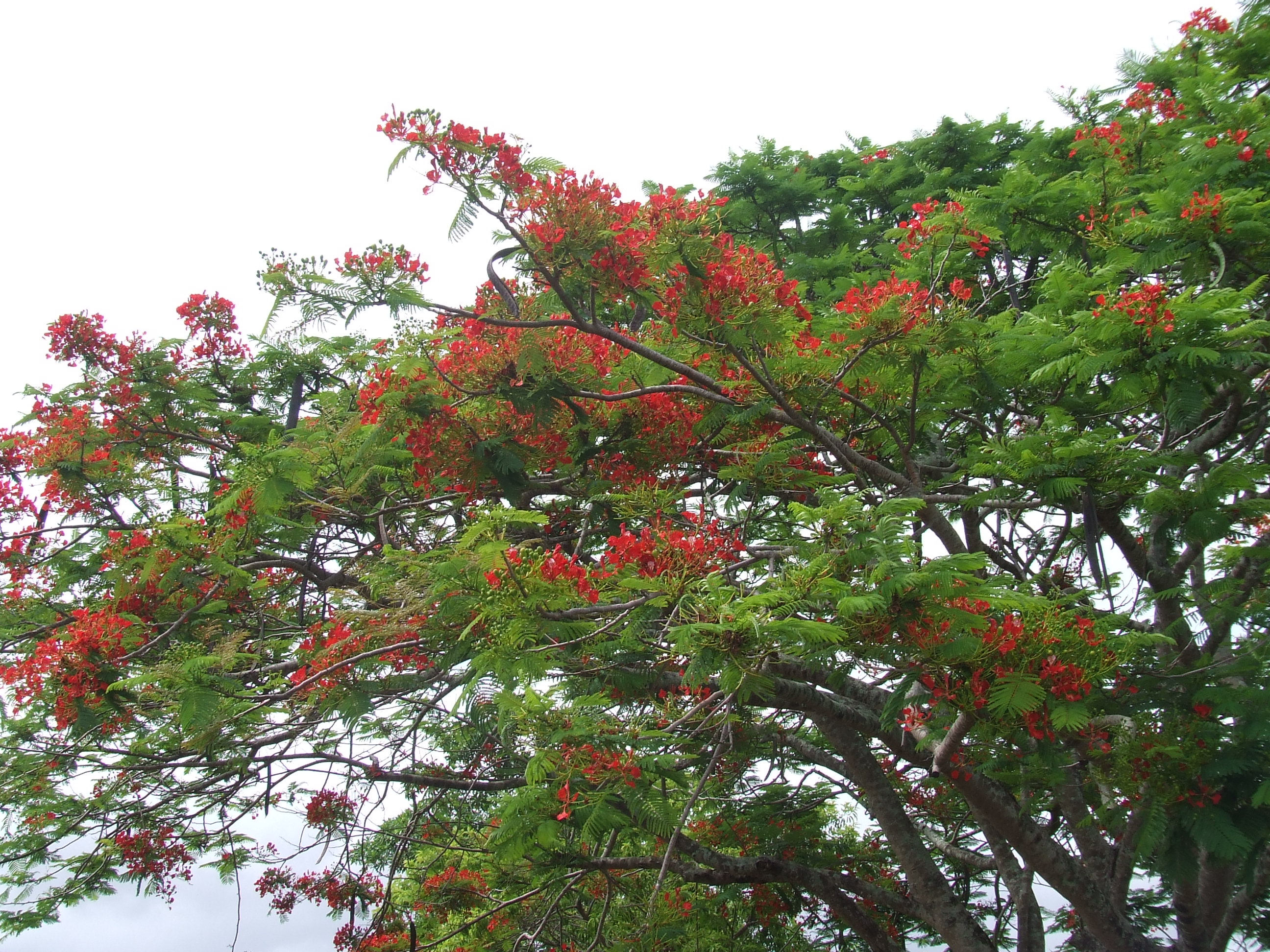 ''Delonix regia'' is endemic to Madagascar's dry deciduous forests, but has been introduced into tropical and sub-tropical regions worldwide. In the wild it is endangered, but it is widely cultivated elsewhere and is regarded as naturalised in many of the locations where it is grown:
''Delonix regia'' is endemic to Madagascar's dry deciduous forests, but has been introduced into tropical and sub-tropical regions worldwide. In the wild it is endangered, but it is widely cultivated elsewhere and is regarded as naturalised in many of the locations where it is grown:
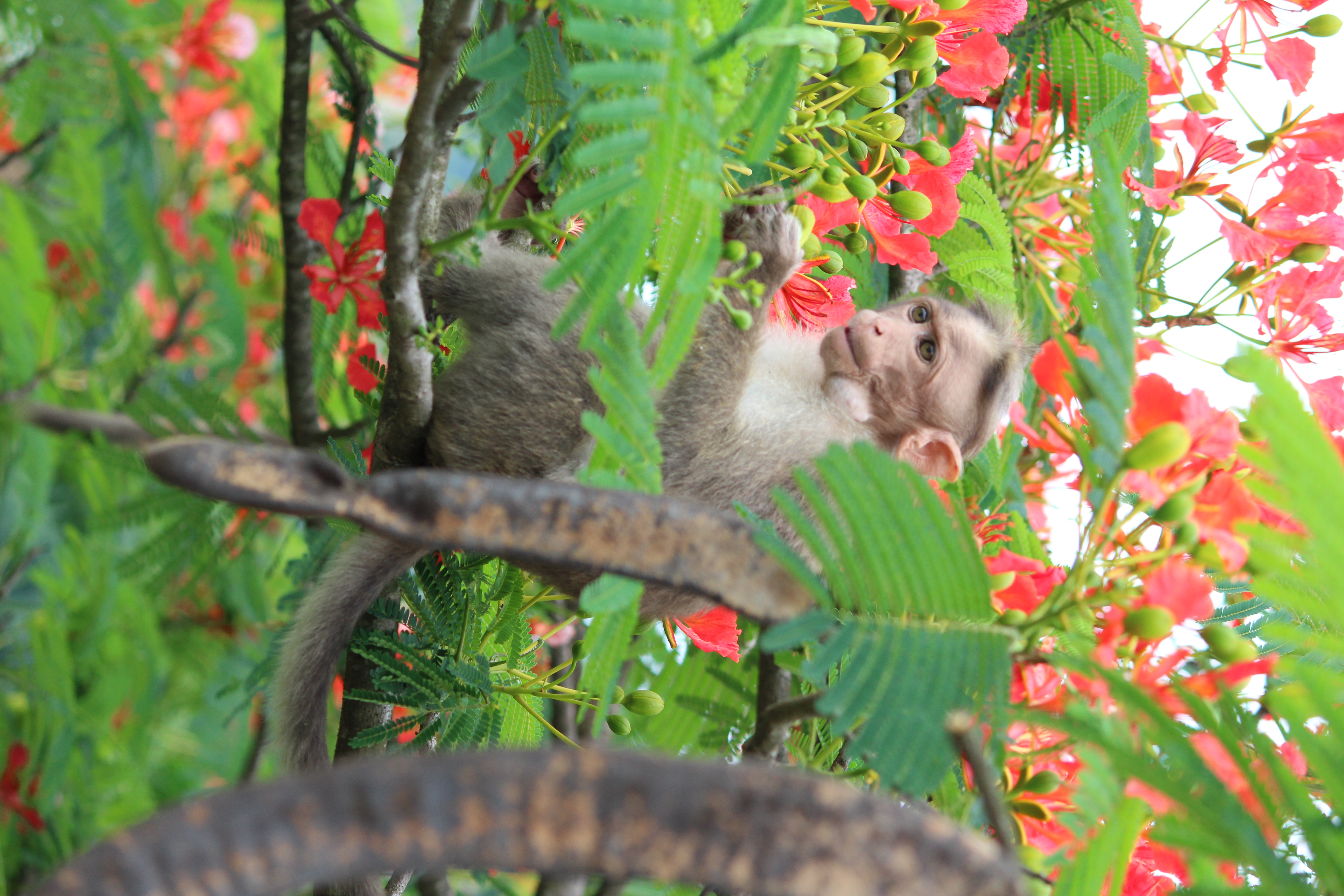 The tree is planted in India, where it is referred to as the ''May-flower tree'', ''Gulmohar'' or ''Gul Mohr.'' In West Bengal, Odisha it is called krushnachuda(Ó”ĢÓ¦āÓ”ĘÓ¦ŹÓ”ŻÓ”ÜÓ¦éÓ”ĪÓ”╝Ó”Š/Ó¼ĢÓŁāÓ¼ĘÓŁŹÓ¼ŻÓ¼ÜÓŁéÓ¼ĪÓ¼╝Ó¼Š). In Sri Lanka it is known in Sinhala as the ''Maara tree'', although for a short while it was known as the ''Lamaasuriya tree'' after Le Mesurier, the British civil servant who was responsible for introducing it as a shade tree. It is also grown in Karachi, Pakistan. In Mauritius and La R├®union it announces the coming of the new year.
In Bangladesh it known as krisnachura(Ó”ĢÓ¦āÓ”ĘÓ¦ŹÓ”ŻÓ”ÜÓ¦éÓ”ĪÓ”╝Ó”Š). You can find this tree in various places of Bangladesh. It is found all over Dhaka City and is one of iconic symbols of the Bengali month of Boishakh.
The tree is planted in India, where it is referred to as the ''May-flower tree'', ''Gulmohar'' or ''Gul Mohr.'' In West Bengal, Odisha it is called krushnachuda(Ó”ĢÓ¦āÓ”ĘÓ¦ŹÓ”ŻÓ”ÜÓ¦éÓ”ĪÓ”╝Ó”Š/Ó¼ĢÓŁāÓ¼ĘÓŁŹÓ¼ŻÓ¼ÜÓŁéÓ¼ĪÓ¼╝Ó¼Š). In Sri Lanka it is known in Sinhala as the ''Maara tree'', although for a short while it was known as the ''Lamaasuriya tree'' after Le Mesurier, the British civil servant who was responsible for introducing it as a shade tree. It is also grown in Karachi, Pakistan. In Mauritius and La R├®union it announces the coming of the new year.
In Bangladesh it known as krisnachura(Ó”ĢÓ¦āÓ”ĘÓ¦ŹÓ”ŻÓ”ÜÓ¦éÓ”ĪÓ”╝Ó”Š). You can find this tree in various places of Bangladesh. It is found all over Dhaka City and is one of iconic symbols of the Bengali month of Boishakh.

 It grows in Southern China such as in Hong Kong. It is the official tree in Tainan, Taiwan; Xiamen, Fujian Province, and
It grows in Southern China such as in Hong Kong. It is the official tree in Tainan, Taiwan; Xiamen, Fujian Province, and
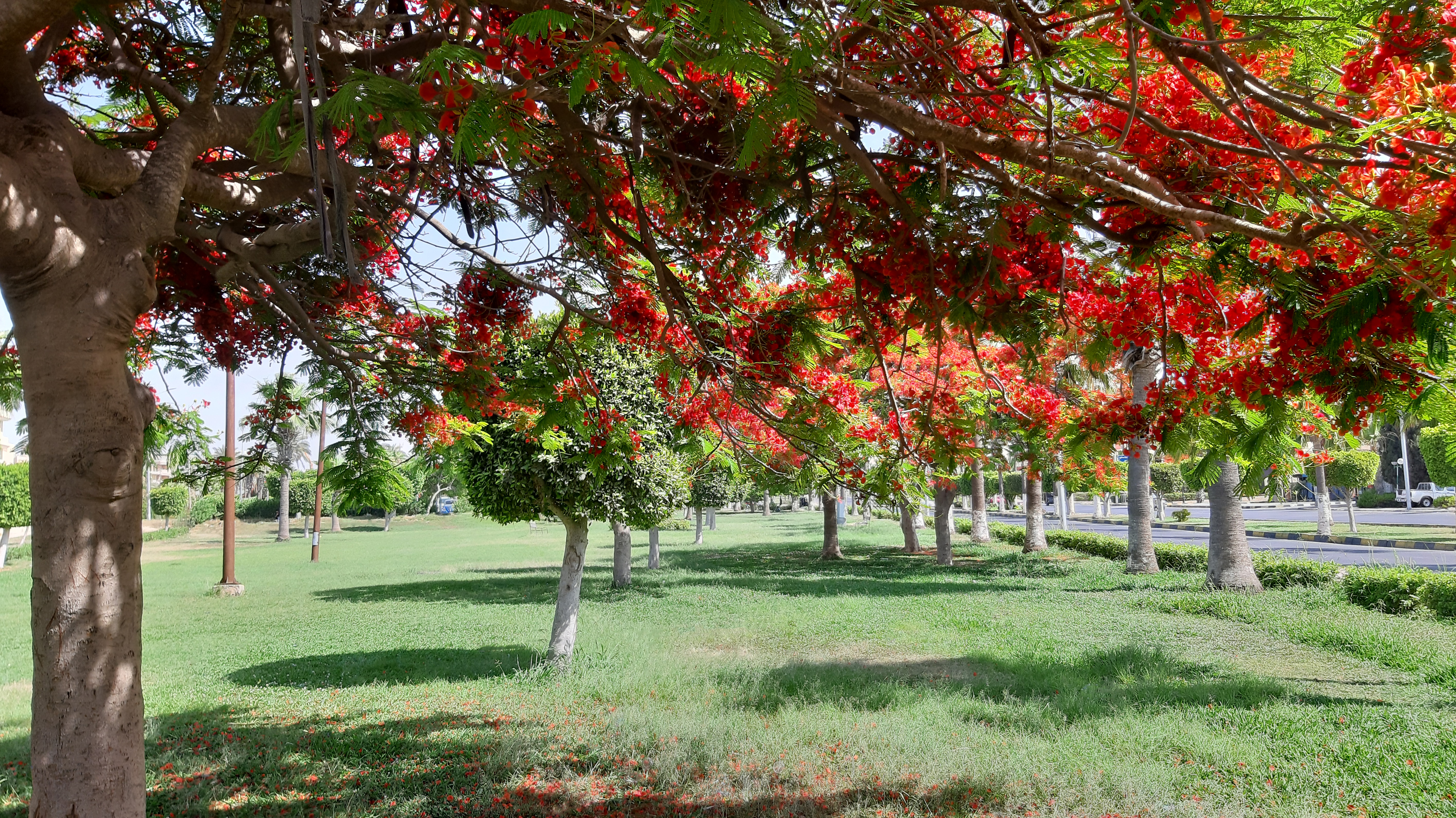
 The royal poinciana is most commonly propagated by seeds. Seeds are collected, soaked in warm water for at least 24 hours, and planted in warm, moist soil in a semi-shaded, sheltered position. In lieu of soaking, the seeds can also be "nicked" or "pinched" (with a small scissors or nail clipper) and planted immediately. These two methods allow moisture to penetrate the tough outer casing, stimulating germination. The seedlings grow rapidly and can reach in a few weeks under ideal conditions.
The royal poinciana is most commonly propagated by seeds. Seeds are collected, soaked in warm water for at least 24 hours, and planted in warm, moist soil in a semi-shaded, sheltered position. In lieu of soaking, the seeds can also be "nicked" or "pinched" (with a small scissors or nail clipper) and planted immediately. These two methods allow moisture to penetrate the tough outer casing, stimulating germination. The seedlings grow rapidly and can reach in a few weeks under ideal conditions.
Floridata data base
* ARKive ŌĆ
images and movies of the flame tree ''(Delonix regia)''
Scientific information about ''Delonix regia''
* * {{Authority control regia Endemic flora of Madagascar Ornamental trees Decorative fruits and seeds Taxa named by Wenceslas Bojer Taxa named by William Jackson Hooker Taxa named by Constantine Samuel Rafinesque
Caesalpinioideae
Caesalpinioideae is a botanical name at the rank of subfamily, placed in the large family Fabaceae or Leguminosae. Its name is formed from the generic name ''Caesalpinia''. It is known also as the peacock flower subfamily. The Caesalpinioideae ...
native to Madagascar. It is noted for its fern-like leaves and flamboyant display of orange-red flowers over summer. In many tropical parts of the world it is grown as an ornamental tree
Ornamental plants or garden plants are plants that are primarily grown for their beauty but also for qualities such as scent or how they shape physical space. Many flowering plants and garden varieties tend to be specially bred cultivars that i ...
and in English it is given the name royal poinciana, flamboyant, phoenix flower, flame of the forest, or flame tree (one of several species given this name).
This species was previously placed in the genus ''Poinciana'', named for Phillippe de Longvilliers de Poincy
Phillippe de Longvilliers de Poincy (1584ŌĆō1660) was a French nobleman and Bailiff Grand Cross of the Knights of Malta. He governed the island of Saint Christopher from 1639 to his death in 1660, first under the Compagnie des ├Äles de l'Am├®riqu ...
, the 17th-century governor of Saint Christopher ( Saint Kitts). It is a non-nodulating legume
A legume () is a plant in the family Fabaceae (or Leguminosae), or the fruit or seed of such a plant. When used as a dry grain, the seed is also called a pulse. Legumes are grown agriculturally, primarily for human consumption, for livestock f ...
.
Description

┬Ąm
The micrometre ( international spelling as used by the International Bureau of Weights and Measures; SI symbol: ╬╝m) or micrometer (American spelling), also commonly known as a micron, is a unit of length in the International System of Unit ...
in size. 
Distribution



North America
In the continental United States, it grows inSouth Florida
South Florida is the southernmost region of the U.S. state of Florida. It is one of Florida's three most commonly referred to directional regions; the other two are Central Florida and North Florida. South Florida is the southernmost part of th ...
, Central Florida, and in the Rio Grande Valley of South Texas
South Texas is a region of the U.S. state of Texas that lies roughly south ofŌĆöand includesŌĆöSan Antonio. The southern and western boundary is the Rio Grande, and to the east it is the Gulf of Mexico. The population of this region is about 4.96 ...
. It also grows in humid parts of Mexico, especially in the Yucatan peninsula.
Caribbean and Central America
In the Caribbean it is featured in many Dominican and Puerto Rican paintings. It can also be found in Belize, The Bahamas, Cuba,Haiti
Haiti (; ht, Ayiti ; French: ), officially the Republic of Haiti (); ) and formerly known as Hayti, is a country located on the island of Hispaniola in the Greater Antilles archipelago of the Caribbean Sea, east of Cuba and Jamaica, and ...
, Dominican Republic, Nicaragua, U.S. Virgin Islands
The United States Virgin Islands,. Also called the ''American Virgin Islands'' and the ''U.S. Virgin Islands''. officially the Virgin Islands of the United States, are a group of Caribbean islands and an unincorporated and organized territory ...
, Sint Maarten,Trinidad and Tobago, Cayman Islands
The Cayman Islands () is a self-governing British Overseas TerritoryŌĆöthe largest by population in the western Caribbean Sea. The territory comprises the three islands of Grand Cayman, Cayman Brac and Little Cayman, which are located to the ...
, Grenada
Grenada ( ; Grenadian Creole French: ) is an island country in the West Indies in the Caribbean Sea at the southern end of the Grenadines island chain. Grenada consists of the island of Grenada itself, two smaller islands, Carriacou and Pe ...
, Jamaica, Cura├¦ao
Cura├¦ao ( ; ; pap, K├▓rsou, ), officially the Country of Cura├¦ao ( nl, Land Cura├¦ao; pap, Pais K├▓rsou), is a Lesser Antilles island country in the southern Caribbean Sea and the Dutch Caribbean region, about north of the Venezuela coast ...
and Saint Vincent And The Grenadines. It is the national flower of St. Kitts and Nevis
Saint Kitts and Nevis (), officially the Federation of Saint Christopher and Nevis, is an island country and microstate consisting of the two islands of Saint Kitts and Nevis, both located in the West Indies, in the Leeward Islands chain of ...
. It can also be found in Bermuda, and Hawaii. The town of Pe├▒uelas, Puerto Rico, located about west of Ponce, is nicknamed ''El Valle de los Flamboyanes'' ("The Valley of the Poinciana Trees"), as many flamboyant trees are found along the surrounding R├Ło Guayanes
Rio or R├Ło is the Portuguese, Spanish, Italian, and Maltese word for "river". When spoken on its own, the word often means Rio de Janeiro, a major city in Brazil.
Rio or R├Ło may also refer to:
Geography Brazil
* Rio de Janeiro
* Rio do Sul, a ...
, R├Ło Macana
Rio or R├Ło is the Portuguese, Spanish, Italian, and Maltese word for "river". When spoken on its own, the word often means Rio de Janeiro, a major city in Brazil.
Rio or R├Ło may also refer to:
Geography Brazil
* Rio de Janeiro
* Rio do Sul, a ...
, and R├Ło Tallaboa
The Tallaboa River ( es, R├Ło Tallaboa; pron. ta-ya-BO-ah), is a river in Pe├▒uelas, Puerto Rico.
See also
*List of rivers of Puerto Rico
References
External links
USGS Hydrologic Unit Map ŌĆō Caribbean Region (1974)
Rivers of Puerto Ric ...
rivers.
Rivers of Puerto Ric ...
South America
It grows in Paraguay,Guyana
Guyana ( or ), officially the Cooperative Republic of Guyana, is a country on the northern mainland of South America. Guyana is an indigenous word which means "Land of Many Waters". The capital city is Georgetown. Guyana is bordered by the ...
and Brazil.
Europe and the Middle East
''Delonix regia'' is planted in Mediterranean parts of Europe, the Middle East and North Africa, including the southern coast of Spain, the Valencian coast, theCanary Islands
The Canary Islands (; es, Canarias, ), also known informally as the Canaries, are a Spanish autonomous community and archipelago in the Atlantic Ocean, in Macaronesia. At their closest point to the African mainland, they are west of Morocc ...
, Lebanon, Egypt, Iran, Israel, Jordan and Cyprus.
Indian subcontinent

Southeast Asia
InMyanmar
Myanmar, ; UK pronunciations: US pronunciations incl. . Note: Wikipedia's IPA conventions require indicating /r/ even in British English although only some British English speakers pronounce r at the end of syllables. As John C. Wells, Joh ...
, where it is called ''Sein-pann-ni'', the time of flowering is March in the south and early to late April in the north. It is planted in gardens and as a roadside tree. In Myanmar, this tree is a sign of Thingyan Festival (13ŌĆō16/17 April). In the Philippines, its flowering signals the imminent arrival of the monsoon rains
A monsoon () is traditionally a seasonal reversing wind accompanied by corresponding changes in precipitation but is now used to describe seasonal changes in atmospheric circulation and precipitation associated with annual latitudinal oscill ...
. It also grows in Thailand and Indonesia. In Vietnam it is called "phoenix flower" and mostly grows in Haiphong. In Malaysia, it is called "Semarak", used to be the name of a street in the country's capital city, Kuala Lumpur, now renamed as Jalan Sultan Yahya Petra where one of the oldest and highest rank Malaysian university, University of Technology Malaysia
, image_name = UTM-LOGO.png
, image_size =
, caption = Seal
, latin_name =
, motto = Kerana Tuhan Untuk Manusia
, mottoeng = In the Name of God for Mankind
, established =
, closed =
, type = Public research university
, affiliatio ...
's Kuala Lumpur campus is located. "Semarak Api" is also the official flower of the Sepang district.
East Asia
 It grows in Southern China such as in Hong Kong. It is the official tree in Tainan, Taiwan; Xiamen, Fujian Province, and
It grows in Southern China such as in Hong Kong. It is the official tree in Tainan, Taiwan; Xiamen, Fujian Province, and Shantou
Shantou, alternately romanized as Swatow and sometimes known as Santow, is a prefecture-level city on the eastern coast of Guangdong, China, with a total population of 5,502,031 as of the 2020 census (5,391,028 in 2010) and an administrative ...
, Guangdong Province
Guangdong (, ), alternatively romanized as Canton or Kwangtung, is a coastal province in South China on the north shore of the South China Sea. The capital of the province is Guangzhou. With a population of 126.01 million (as of 2020) ...
, People's Republic of China. National Cheng Kung University
National Cheng Kung University (NCKU; ) is a public research university located in Tainan, Taiwan. The university is best known for engineering, computer science, medicine, and planning and design.
As a top university in Taiwan, NCKU has played ...
, a university located in Tainan, put royal poinciana on its emblem.
Australia
It is very widely grown in the Northern Australia, the southern extremes previously limited to South East Queensland where it is a popular street tree in the suburbs of Brisbane. It now grows and blooms successfully inSydney
Sydney ( ) is the capital city of the state of New South Wales, and the most populous city in both Australia and Oceania. Located on Australia's east coast, the metropolis surrounds Sydney Harbour and extends about towards the Blue Mountain ...
and other parts of New South Wales.
Micronesia
It grows in Guam, and is the official tree of the Commonwealth of the Northern Mariana Islands.Cultivation
Required conditions
The royal poinciana requires a tropical or near-tropical climate, but can tolerate drought and salty conditions. It prefers an open, free-draining sandy or loamy soil enriched with organic matter. The tree does not like heavy or clay soils and flowers more profusely when kept slightly dry.
Propagation
Seeds
Cuttings
Less common, but just as effective, is propagation by semi-hardwood cuttings. Branches consisting of the current or last season's growth can be cut into sections and planted in a moist potting mixture. This method is slower than seed propagation (cuttings take a few months to root) but is the preferred method for ensuring new trees are true to form. As such, cuttings are a particularly common method of propagation for the rarer yellow-flowering variety of the tree.Usefulness
In addition to its ornamental value, it is also a useful shade tree in tropical conditions, because it usually grows to a modest height (mostly , but it can reach a maximum height of ) but spreads widely, and its dense foliage provides full shade. In areas with a marked dry season, it sheds its leaves during the drought, but in other areas it is virtually evergreen.Cultural significance
In the Indian state of Kerala, royal poinciana is called ''kaalvarippoo'' (, ) which means "the flower ofCalvary
Calvary ( la, Calvariae or ) or Golgotha ( grc-gre, ╬ō╬┐╬╗╬│╬┐╬ĖߊČ, ''Golgoth├ó'') was a site immediately outside Jerusalem's walls where Jesus was said to have been crucified according to the canonical Gospels. Since at least the early mediev ...
". There is a popular belief among Saint Thomas Christians of Kerala that when Jesus was crucified, there was a small royal poinciana tree nearby his Cross. It is believed that the blood of Jesus Christ was shed over the flowers of the tree and this is how the flowers of royal poinciana got a sharp red color. It is also known as ''Vaaga'' in many areas of Kerala.
Its blossom is the national flower of St. Kitts and Nevis
Saint Kitts and Nevis (), officially the Federation of Saint Christopher and Nevis, is an island country and microstate consisting of the two islands of Saint Kitts and Nevis, both located in the West Indies, in the Leeward Islands chain of ...
, and in May 2018 the royal poinciana was adopted by the city of Key West
Key West ( es, Cayo Hueso) is an island in the Straits of Florida, within the U.S. state of Florida. Together with all or parts of the separate islands of Dredgers Key, Fleming Key, Sunset Key, and the northern part of Stock Island, it cons ...
as its official tree. Known locally as , ''Delonix regia'' is the city flower of Sepang
Pekan Sepang is a small border town and also a mukim in Sepang District, Selangor, Malaysia. The Sepang International Circuit in the western part of the town, where the Malaysian F1 Grand Prix was and Malaysian MotoGP Grand Prix is held. Mal ...
, Selangor, Malaysia.
In Vietnam, this tree is called , or "phoenix's tail", and is a popular urban tree in much of Vietnam. Its flowering season is MayŌĆōJuly, which coincides with the end of the school year in Vietnam. Because of this timing, the flower of poinciana is sometimes called the "pupil's flower". The tree is also commonly found on school grounds in Vietnam, however after several trees incidents where the tree fell on students, with one student killed, schools started cutting down or severely pruning the trees. Hß║Żi Ph├▓ng
Haiphong ( vi, Hß║Żi Ph├▓ng, ), or Hß║Żi Ph├▓ng, is a major industrial city and the third-largest in Vietnam. Hai Phong is also the center of technology, economy, culture, medicine, education, science and trade in the Red River delta.
Haiphong wa ...
is nicknamed ("City of red poinciana").
The song " Poinciana" was inspired by the presence of this tree in Cuba.
References
Further reading
Floridata data base
* ARKive ŌĆ
images and movies of the flame tree ''(Delonix regia)''
External links
*Scientific information about ''Delonix regia''
* * {{Authority control regia Endemic flora of Madagascar Ornamental trees Decorative fruits and seeds Taxa named by Wenceslas Bojer Taxa named by William Jackson Hooker Taxa named by Constantine Samuel Rafinesque